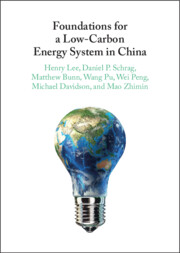Book contents
- Foundations for a Low-Carbon Energy System in China
- Foundations for a Low-Carbon Energy System in China
- Copyright page
- Contents
- Acknowledgments
- 1 Introduction
- 2 Reforming China’s Electricity Market to Facilitate Low-Carbon Transition
- 3 Promoting Large-Scale Deployment and Integration of Renewable Electricity
- 4 Enabling a Significant Nuclear Role in China’s Decarbonization
- 5 Transitioning to Electric Vehicles
- 6 From Barrier to Bridge
- 7 Coordinating Strategies to Reduce Air Pollution and Carbon Emissions in China
- 8 Conclusion
- Index
- References
5 - Transitioning to Electric Vehicles
Published online by Cambridge University Press: 02 December 2021
- Foundations for a Low-Carbon Energy System in China
- Foundations for a Low-Carbon Energy System in China
- Copyright page
- Contents
- Acknowledgments
- 1 Introduction
- 2 Reforming China’s Electricity Market to Facilitate Low-Carbon Transition
- 3 Promoting Large-Scale Deployment and Integration of Renewable Electricity
- 4 Enabling a Significant Nuclear Role in China’s Decarbonization
- 5 Transitioning to Electric Vehicles
- 6 From Barrier to Bridge
- 7 Coordinating Strategies to Reduce Air Pollution and Carbon Emissions in China
- 8 Conclusion
- Index
- References
Summary
In 2018, China had 242 million motor vehicles on the road, with this number due to increase dramatically over the next decade. Its high-speed rail system stretched across most of the country and its airline industry has expanded. If China is going to have the capacity to decarbonize its energy mix, however, it will have to transition its vehicle fleet from one that is dependent on fossil-fuels to one that relies on electricity. In response to public concerns over high pollution levels and energy security, China hopes to have 80 million electric vehicles on the road by 2030. To meet this goal, China will have to accelerate its reform of its electricity system, build an effective electric charging infrastructure, and develop better and less costly battery technologies.
- Type
- Chapter
- Information
- Foundations for a Low-Carbon Energy System in China , pp. 101 - 120Publisher: Cambridge University PressPrint publication year: 2021



